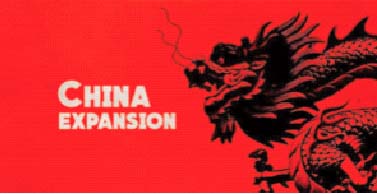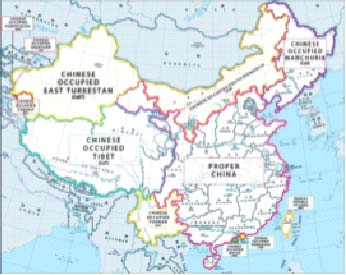From Tibet to Mongolia to Xinjiang to Hong Kong, story of China in the last century is the story of its expansion and illegal occupation of lands that never belonged to it These territories are merely resource areas to feed Han Chinese in the mainland
-Dr Gulrez Sheikh

China is poised to fall under the weight of its own hegemonistic expansion
China, with its vast geography, is not a homogenous red dragon as most people think. Only reason behind the myth about the happy red, prosperous state is the presence of an iron curtain. Decades ago, most people had same myths about USSR but when the artificially built system collapsed due to its own weight, truth came out.
The heartland China or popularly called mainland China is basically the land of Han Chinese (about 90%), the rest being ethnically different entities. There are huge disparities between the economic and infrastructural development of the Han heartlands vs other and is one of the important reason behind the OBOR (One Belt One Road) project.
The prosperous Chinese cities with a fantastic skyline are all situated in the Han heartland. In contrast, North-East China, Inner Mongolia, Xinjiang, Tibet are poor and struggling-revolting under the iron curtain and are dealt with the Iron wrist of the state since decades.
So what makes the Chinese heartland?
There are 18 states which constitute the heartland China and these are: Anhui, Chihli, Fujian, Gansu, Guangdong, Guizhou, Hebei, Henan, Hubei [Zhili], Hunan, Jiangsu, Jiangxi, Shaanxi, Shanxi, Shangdong, Sichuan, Yunnan (for most of its history remained an independent principality) and Zhejiang.
Rest of the provinces or the autonomous regions, Heilongjiang, Kirin [Jilin], Liaoning, Nei Monggol (Inner Mongolia), Guangxi, Xinjiang, Ningxia, are under the domination of China. This soft underbelly of PRC are much less developed than the 18 HAN provinces. Let’s focus on each of them.
Nei Monggol (Inner Mongolia)
Nei Monggol or Inner Mongolia is basically Mongolia. The Great Wall of China was built to protect the HAN Chinese kingdoms from the Mongol invasions. So whatever is typically north of the Great Wall is Mongolia and was never a part of classical China. When the Qing Dynasty collapsed in 1911, there was Mongolia which wanted to be independent, and a Khanate was established under Bogd Khaan (descendant of Genghis Khaan). Due to internal politics, some members of Mongolia sought assistance from Beijing. Eventually, the Chinese Communist Party subjugated the southern part of Mongolia and created Nei Monggol.
Guangxi
Guangxi is located in South China, bordering Vietnam. The Qing dynasty recognised it as an independent state till 1726. Till 1885, it was a region of constant revolt. When the Qing Dynasty collapsed in 1911, Guangxi succeeded to form an independent state. In 1929, The Baise Uprising (Youjiang Riots) was instigated by the Communist Party of China under the guidance of Deng Xiaoping. Throughout 1920’s this remained an area of major civil war and is still under the title of an autonomous region.
Xinjiang
Often in the news due to the ongoing genocide of the Uyghur Muslims. Uyghurs are a caucasian race, having cultural similarities with Indo-Iranians. They are originally Turkish-Mongol people.
The Qing Dynasty brought Xinjiang under its control and did the very same thing what the Communist Party is doing with them today, i.e., replacing Uyghurs with Han Chinese in all the major cities and changing the demographics. The Uyghurs call there land as East Turkestan. Earlier reference works often refer to the area as Chinese Turkestan. Throughout history, it was never called China.
Ningxia
A small landlocked region in the North-West of China and right next to the Great Wall. It is home of Hui people, one of the 56 ethnic minorities officially recognised by PRC. Imperial China used this area to station its military outposts to take care of Mongol invaders. This small area was never a part of China. China first tried to incorporate it into Gansu in 1954, but was separated from Gansu in 1958 and was reconstituted as an autonomous region.
The occupied territory of Tibet
Another story of Chinese expansionism is Tibet. After annexation, China divided Tibet into Xizang (consisting of Lasa) and Quinhai (on the other side of the Himalayas). The Tibetan government in exile shows both Xizang & Quinhai in its map with Lasa as its capital. The natural access to Tibet is easier from Aksai Chin than from areas around Quinhai. Due to this, Buddhism reached Tibet from India. Even in recent history, Maharaja of Jammu & Kashmir used to claim parts of Tibet as part of his empire.

A map of China which showcases all
its territorial occupations and claims
its territorial occupations and claims
Erstwhile Manchuria
Erstwhile Manchuria is North of the Korean peninsula and is an underdeveloped part of China with no roots to the Han Chinese. The area consists of three major provinces- Heilongjiang, Kirin and Liaoning. The natives of Heilongjiang are known as Mongol-Dongu people. For most of history, it was a no-go territory for Han Chinese. While Kirin are ethnically not Chinese, in Liaoning, most people are of Korean descent.
Entire region of erstwhile Manchuria came into the Chinese fold either as a gift or due to support of USSR, as this region was a colony of imperial Japan and was captured by the Soviets during WWII.
The heartland China or popularly called as the mainland China is basically the land of HAN Chinese, making 90% of its population but occupying about 1/3 of the landmass. The rest are ethnically different entities
Hong Kong
Handed over to the PRC in 1997 by the United Kingdom. Though the majority of its population is HAN Chinese, since it has tasted freedom under the British rule, today it is struggling for its democratic rights.
These provinces and the so-called autonomous regions form the soft underbelly of communist China and are glued to the mainland due to money and muscle. Once either of the two is gone, PRC will have the same story as that of Yugoslavia or the USSR.
Unlike democracies, the authoritarian states do not have the luxury to change an unpopular government via elections; rather, it ensures the collapse of the entire system leading to Balkanisation.
(The writer is a Bhopal based columnist and political commentator)













Comments